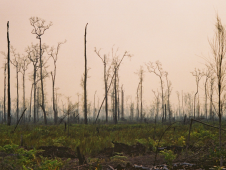
In Indonesia during 1997–1998, fires caused by humans damaged or destroyed almost 50,000 km2 of forest in Borneo and Sumatra. Research shows that the density of hornbill species decreased because of sparse canopy and scarcity of fruit.
In rainforest, natural fires are extremely rare, and birds and other biodiversity suffer greatly when human-initiated fires occur. Burnt forest may take hundreds or possibly thousands of years to return to its original state (Chambers et al. 1998). Human activity worsens the risk of fire and its negative impacts for a variety of reasons. For example:
In Indonesia during 1997–1998, fires damaged or destroyed almost 50,000 km2 of forest in Borneo and Sumatra (an area larger than Switzerland) (Liew et al. 1998). Although made worse by a drought induced by El Niño, these fires were caused by humans. The 1997 fires released as much carbon into the atmosphere as the total annual carbon intake of the world’s vegetation, equivalent to Europe’s current annual carbon emissions from the combustion of fossil fuels (Page et al. 2002). Research at Bukit Barisan Selatan National Park, Sumatra, showed that the density of hornbill species decreased by 28–63% in fire-damaged forest, because of the sparse canopy and scarcity of fruit (Anggraini et al. 2000), whilst breeding productivity of red-knobbed hornbills Aceros cassidix decreased in burned sites of Tangkoko Nature Reserve, resulting in a 47% decline in recruitment (Cahill and Walker 2000). Bird composition was also largely affected by fire severity, with insectivores being most negatively affected, and these changes likely due to changes in vegetation structure and type (Adeney et al. 2006).
References
Compiled: 2004 Last updated: 2007
Recommended Citation:
BirdLife International (2007)
In Indonesia, human-initiated fires are responsible for massive losses of rainforest .
Downloaded from https://datazone.birdlife.org/sowb/casestudy/in-indonesia-human-initiated-fires-are-responsible-for-massive-losses-of-rainforest- on 22/12/2024